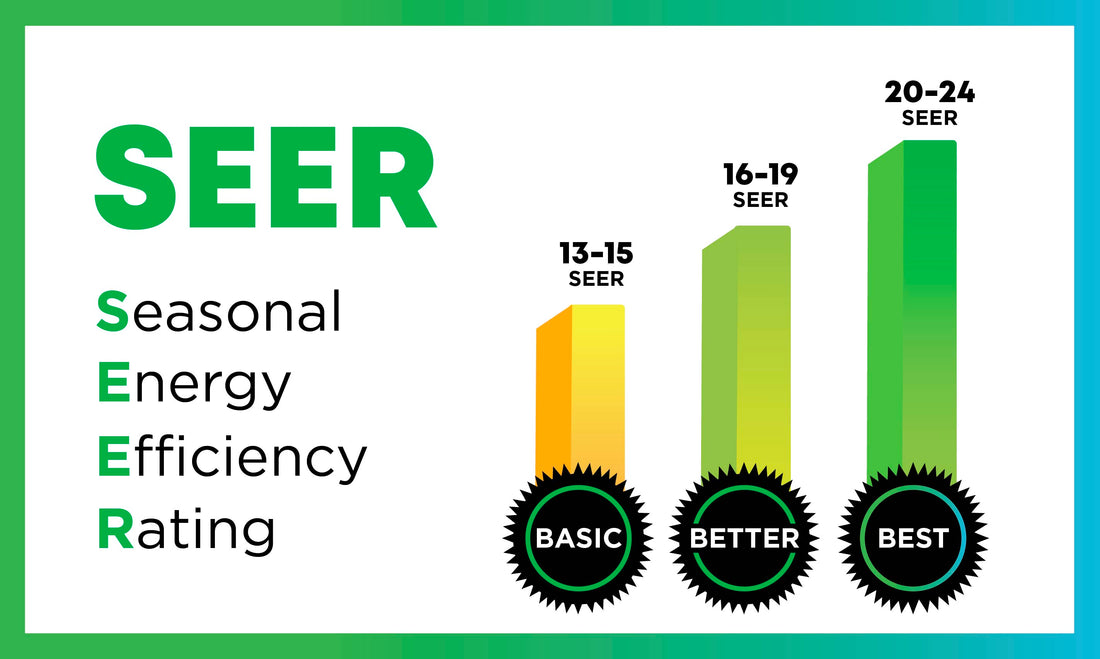
Understanding SEER Ratings: What They Mean for Your Air Conditioner
SEER stands for Seasonal Energy Efficiency Ratio. It’s a standard measurement used to rate how efficiently an air conditioning system converts electricity into cooling power over an entire cooling season. The higher the SEER rating, the more energy efficient the system is, and the less it costs to keep your home comfortable during hot weather[1][2][12].
How Is SEER Calculated?
The SEER rating is calculated by dividing the total cooling output of an air conditioner (measured in British Thermal Units, or BTUs) during a typical cooling season by the total electric energy input (in watt-hours) over the same period. This gives you an average efficiency rating that reflects real-world use, not just ideal lab conditions[2][3][12].
Why Does SEER Matter?
- Lower Energy Bills: Higher SEER ratings mean your air conditioner uses less electricity to cool your home, which can significantly reduce your monthly energy costs[1][2][10].
- Environmental Impact: Efficient systems help lower your carbon footprint by using less energy, making them better for the environment[3][4][12].
- Comfort: Many high-SEER units also offer improved humidity control and quieter operation, leading to a more comfortable home.
SEER Rating Scale: What’s a Good Number?
SEER ratings for modern air conditioners usually range from 13 to 25. Here’s a quick breakdown of what those numbers mean[1][4][10]:
- 13–14: Standard efficiency. These units meet the minimum government requirements.
- 15–17: Better efficiency. These units offer lower energy use and bills.
- 18–21: High efficiency. These systems provide significant energy savings and may qualify for rebates.
- 22–25: Top-tier efficiency. These are the most advanced and efficient models available.
In many areas, the minimum allowable SEER rating for new systems is 13 or 14, but choosing a higher SEER can mean greater long-term savings[1][12].
SEER vs. SEER2: What’s Changed?
As of January 1, 2023, SEER2 replaced the original SEER standard. SEER2 uses updated testing procedures that better reflect real-world conditions, including ductwork losses and airflow resistance. This change means SEER2 ratings are more accurate and help you make more informed choices about your home's cooling system[8][12].
Factors That Affect SEER Ratings
- Compressor and Fan Motor Efficiency: Advanced motors and compressors use less energy to deliver the same cooling power[2][4].
- System Size and Design: Properly sized and designed systems operate more efficiently.
- Installation Quality: Even a high-SEER unit won’t perform well if it’s installed incorrectly. Always use a qualified HVAC professional.
- Maintenance: Regular filter changes and annual tune-ups keep your system running at peak efficiency. Dirty filters or neglected parts can lower your system’s effective SEER over time[3][4].
- Climate: Hotter, more humid climates may benefit more from higher SEER ratings, as the AC runs more often.
SEER Ratings and Energy Star
Air conditioners with higher SEER ratings often qualify for the ENERGY STAR label. ENERGY STAR-certified units are at least 15% more efficient than standard models, helping you save money and reduce environmental impact[1][3].
How SEER Impacts Your Wallet
While higher SEER air conditioners usually cost more upfront, they can pay for themselves over time through lower energy bills. For example, upgrading from a 13 SEER to a 16 SEER unit can cut your cooling costs by up to 30%. The more you use your AC, the more you save with a higher SEER system[2][10].
Choosing the Right SEER for Your Home
- Budget: Balance the upfront cost with potential long-term savings. Higher SEER units cost more initially but can save you more in the long run.
- Usage: If you use your AC frequently or live in a hot climate, a higher SEER rating makes more sense.
- Rebates and Incentives: Some utility companies and government programs offer rebates for high-efficiency systems. Check what’s available in your area.
- Home Size and Insulation: Larger homes or those with poor insulation may benefit from higher SEER systems for better efficiency and comfort.
Maintaining Your Air Conditioner’s Efficiency
Your air conditioner’s SEER rating is determined at the factory and doesn’t change over time, but its actual efficiency can drop if you skip regular maintenance. Change your filters regularly, schedule annual professional tune-ups, and keep the outdoor unit free of debris to keep your system running at its best[3][4].
Key Takeaways
- SEER ratings help you compare the energy efficiency of different air conditioners.
- Higher SEER means lower energy bills and a smaller environmental footprint.
- Choosing the right SEER depends on your budget, climate, and how much you use your AC.
- Proper installation and regular maintenance are just as important as the SEER number itself.
Ready to Upgrade or Need More Advice?
At Dan The Filter Man, we’re here to help you find the best air conditioning solution for your home. Whether you’re looking to upgrade to a high-efficiency system or just want to make sure your current AC is running at its best, our team is ready to help. Contact us today to schedule a consultation or learn more about maximizing your home comfort and savings!
At DanTheFilterMan.com, we're committed to helping you find the best solutions for your HVAC needs. Whether you're looking for advice on furnace filters or need assistance with maintenance, feel free to reach out to us today!


